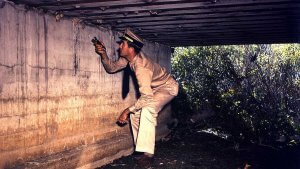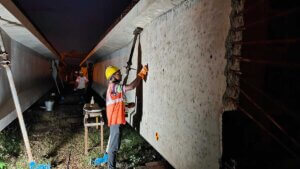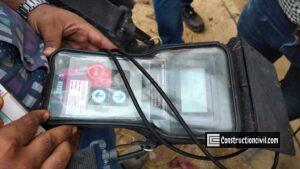Different types of defects in concrete are found in various structures, and the reasons for the defects of concrete structures are either physical or chemical processes. The following signs of deterioration commonly observed in concrete structures are changes in texture or colour of concrete and cracking.
Investigation for Defects of Concrete Structure:
Locations to be specially looked for the defects of concrete structures during the condition survey are as follows:
- The general condition of the structure and prestressed components
- Overall condition of the concrete
- Cracks, delamination, leaching, scaling or damage due to accident or any other causes
- Rusting or corrosion signs
- Condition of construction joints, the junction of girders and diaphragm, joints in segmental construction
- Condition of cable end sealing
- Damage due to abrasive action and seepage
- Around the bearing support and bottom of girder above bearing should be inspected for Spalling/crushing/cracking.

Also, Read: Concrete Ingredients – Important Properties and Tests
Defects in Concrete Structure:
The following types of defects in concrete structures are commonly observed during the existing structure condition survey.
Concrete Cracks:
Complete or incomplete gaps that divide the running surface of the concrete into two or more parts are created due to the separation of a continuous concrete surface, known as concrete cracks. Concrete cracks may occur either in the plastic or hardened state of concrete, depending on many different factors. It can affect the aesthetic view of the concrete structure and may indicate significant structural distress or a lack of durability.
Structural Cracks:
The typical reason behind structural cracks is excess loading, faulty construction, differential settlement, impact on account of the accident, chemical reaction, weathering, excessive loss of prestressing, corrosion of steel, errors in design and detailing, earthquake, fire, etc.
Non-Structural Cracks:
Apart from the above-mentioned structural cracks, the following types of cracks can be observed shrinkage cracks, thermal cracks, cracks in fresh concrete, etc., known as non-structural cracks, and due to changes in concrete mix design ratios, environmental effects and lack of proper curing etc.
Measurement of Crack Width:
A simple small convenient Tell-tell plus crack monitor may be used. Where greater measurement accuracy is required, transducer, extensometer, or strain gauges can be used.
Recording of Crack:
During the site visit, whenever cracks are noticed, the following data should be recorded in a prescribed format:
- Location of the cracks
- Width, depth and length of the crack in detail
- Type and pattern of crack by visual inspection
- Whether it is an active or dormant types
- Behaviour under live load condition

Also, Read: Rusting of Iron Rebar in Concrete – Special Repairing
Pattern of Cracks and Possible Causes:
| Structural Element | Location | Crack pattern/ Direction | Possible causes |
| Soffit of slab or girder | End of span | Longitudinal | (i) Bursting stress (ii) Lack of anchorage block reinforcement (iii) Alkali-Silica reaction in concrete |
| Soffit of slab or girder | Mid span | Longitudinal | (i) Alkali-Silica reaction in concrete (ii) Broken tendons |
| Soffit of slab or girder | Mid span | Transverse | (i) Loss of prestress (ii) Excess of live load |
| Web | End of span | Diagonal | (i) Sheer stressLoss of prestress |
| Web | End of span | Longitudinal | (i) Alkali-Silica reaction in concrete (ii) Duct Flotation (iii) Broken tendons |
| Web(Cantilever/ Continuous girders) | Over support | Vertical | (i) Loss of pre-stress |
| Top flange (I-girder or Box girder) | Mid span | Transverse | (i) Differential shrinkage |
| Top flange (I-girder or Box girder) | Over support | Longitudinal | (i) Alkali-Silica reaction in concrete (ii) Broken tendons |
| Top flange (I-girder or Box girder) | Over support | Transverse | (i) Differential shrinkage (ii) Loss of prestress (iii) Excess of live load |
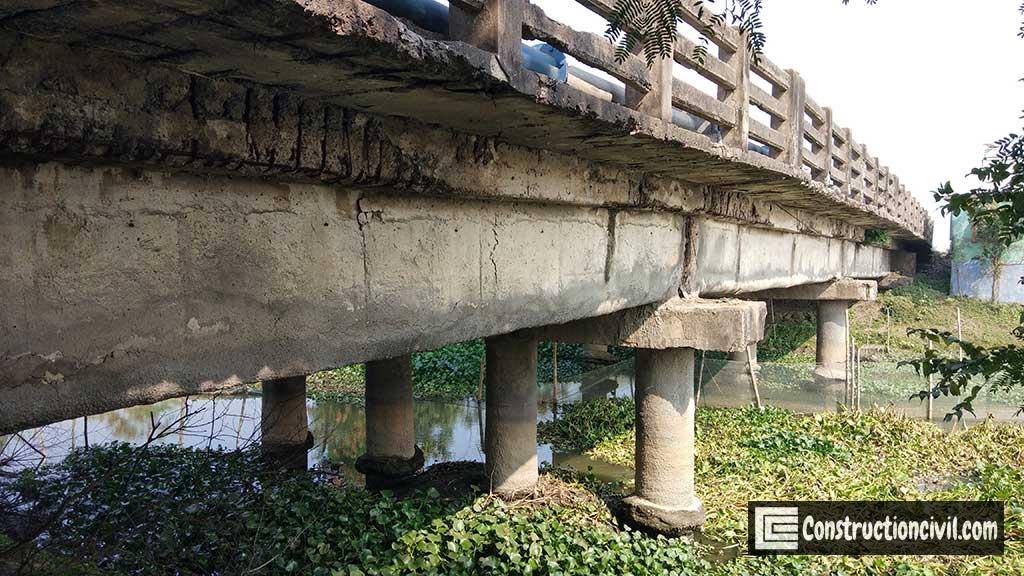
Also, Read: Blowholes/Surface voids/Bugholes in Concrete Surface
Spalling of Concrete:
Spalling is the defects in concrete structure of surface or sub-surface fatigue, which causes cracks to form in the running surface of the concrete. Spalling is the effect of surface or sub-surface fatigue; when a portion of concrete gets separated, showing a fracture parallel or inclined to the surface, called spalling. Spall is flakes of material that are broken off a larger solid body due to excessive rolling pressure.
Significant Causes of Spalling:
- Corrosion of steel reinforcement
- The freezing of cracked or porous concrete
- Chemical attack
- Poor quality concrete
Delamination of Concrete:
The separation of a thin surface layer of concrete from an existing concrete surface is called delaminations. In the case of delaminations, concrete paste gets separated along a plane parallel to the surface of the concrete. This type of defects in concrete Structure commonly develops due to concrete characteristics, daytime temperature hikes and the adopted finishing method.
Significant Causes of Delamination:
- Corrosion of reinforcement, inadequate cover and fire can be cases of concrete delamination.
- In the case of a thick concrete slab, there is a slow setting of underlying concrete due to low temperature at the base compared to the top surface.
- The concrete temperature or mixed ingredients impedes the setting time of concrete, which causes delamination.
- High air content is present in concrete as compared to the required limit.
- It is occurring rapid drying situation due to the environmental effects.
- Excessive vibration can cause draw excess mortar to the surface.
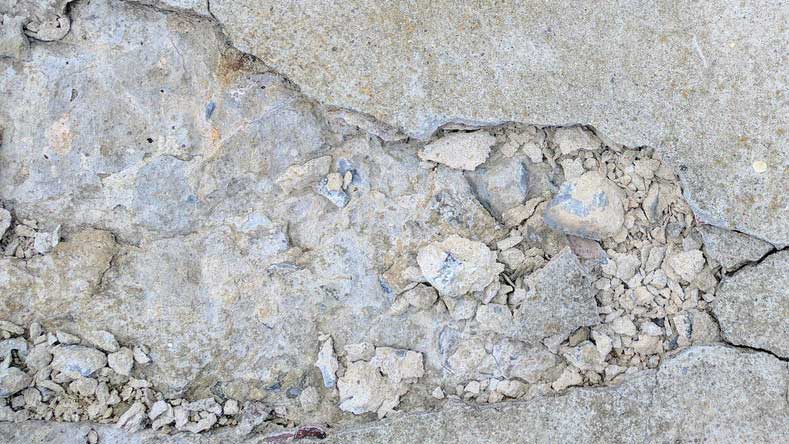
Also, Read: Causes, Prevention and Repair of Concrete Surface Defects
Scaling of Concrete:
Scaling in concrete is known as local flaking or peeling of an existing surface of hardened concrete resulting in a continuous loss of mortar and aggregate over an area. It occurs due to hydraulic pressures from repeated cycles of water freezing present in the concrete, and the expansive force of ice formation is one of the main reasons behind the scaling of concrete.
Significant Causes of Scaling:
- It is observed where repeated freeze and thaw action on concrete occurs or when the concrete surface gets subjected to wetting and drying cycles.
- Using concrete with low strength or excessively high water-cement ratio.
- Improper finishing procedures that trap water at the surfaces can cause scaling.
- Lack of or inadequate curing and concrete surface protection.
- Exposure to corrosive salts and fertilizers can be the reason for the scaling of concrete.
Rust streaks:
The presence of rust or stain marks on the side and bottom surfaces of the concrete member is called rust streaks.
Significant Causes of Rust streaks:
- pH value of old concrete
- Inadequate cover of the reinforcement
- Carbonation
- Permeability of concrete
- Exposure to an aggressive environment
- Incomplete grouting of ducts of tendons
- Besides, the HTS strands are more prone to corrosion by a phenomenon known as “STRESS CORROSION.”
Also, Read: Design Mix of Concrete – Detailed Procedure With Calculation
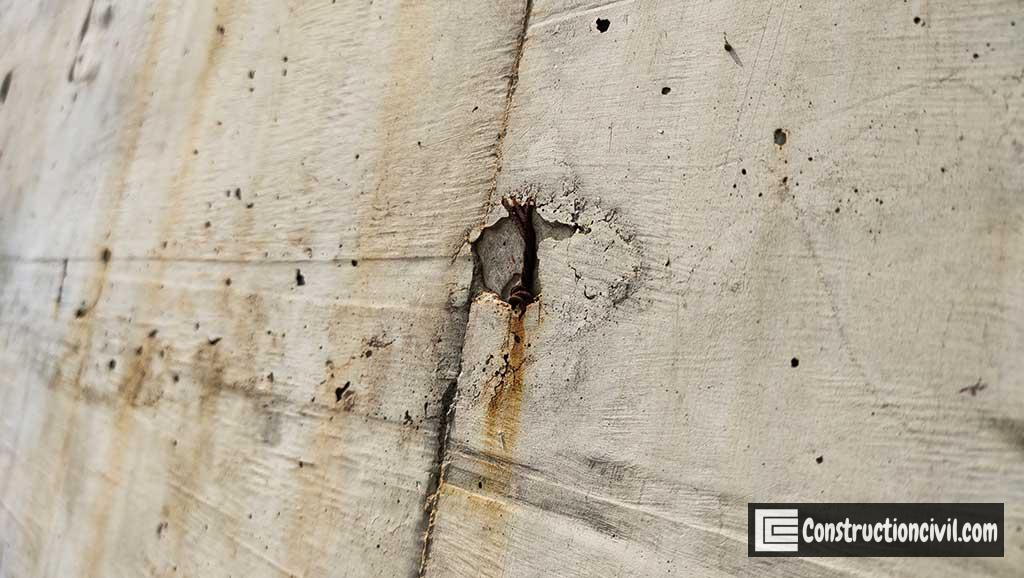
Also, Read: Bridge Inspection Types – Objectives and Guidelines
Leaching:
Defects in Concrete due to leaching happen gradually in structures in long-term contact with water resulting in the dilution of calcium from the concrete matrix, which is a major chemical component of concrete and is called leaching.
Significant Causes of Leaching:
Concrete is a hardened mixture of cement, sand and aggregate, and the main components of cement are calcium and silicon. Hardening of cement occurs by the hydration method and releases calcium compounds. Concrete is a porous material where pores are connected and form a network. When the calcium compounds dissolve due to leaching in water, they invade the pores. After the leaching of concrete, dissolved and ionized calcium migrates into the concrete medium. As a result, where the concrete is in contact with water, the solidified cement component of the concrete is dissolved gradually. This type of dilution increases the porosity of the structural component, and hence durability of concrete gets reduced.
In case of deterioration due to leaching, the aggregates will be visible without the cementitious material.
Also, Read: Properties of Concrete – Introduction to Good Concrete Practice
Erosion of Concrete:
Erosion is the action of surface processes, and it caused due to abrasive action on the deck top or by high-velocity river water in piers may even lead to the formation of pocket or cavity called the erosion of concrete.
Significant Causes of Erosion:
- Insufficient cover of reinforcement
- Environmental effects like heating and freezing
- The concrete quality which is used
- Chemical attack
- Abrasion erosion of concrete in underwater structures caused by water-transported sand, silt, gravel, ice, or debris
- Cavitation erosion results from the collapse of vapour bubbles created by pressure changes under a high-velocity water flow.
Loss of Camber Causes Defects of Concrete Structure:
Loss of camber may be caused by settlement, overloading, or deterioration of concrete due to stress or corrosion. In the case of prestressed concrete girders, loss of camber may occur due to loss of prestressing, which needs investigation.
Also, Read: Nondestructive Testing of Concrete – Methods & Guidelines



